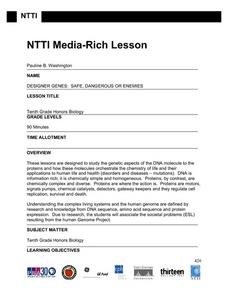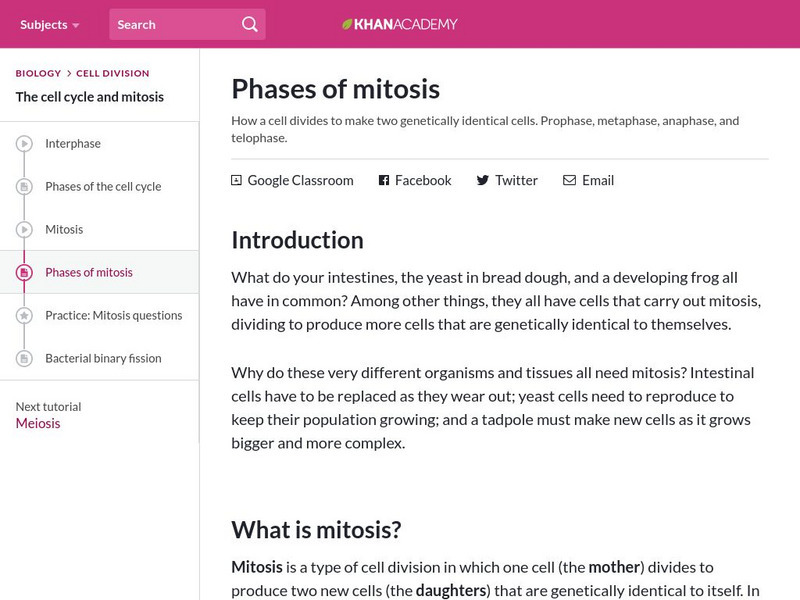Virginia Department of Education
Structure and Function of Cell Membranes
Lead your high school class on an exploration inside the cell. Individuals investigate the relationships between cells structure and function given their relative locations on the cell membrane. They explore the concept of homeostasis...
Virginia Department of Education
The Ratio of Surface Area to Volume
Demonstrate the ratio of surface area to volume in your high school class by using phenolphthalein, gelatin, and an onion. Intrigue the class by leading a discussion on osmosis and diffusion, then making "scientific jello." Participants...
Virginia Department of Education
Genetic Variation and Mutations
Young scientists demonstrate their creativity while completing several activities, to assess genetic variations and mutations. Instructors provide a list of options and scientists choose to write a comic strip, create a book,...
Virginia Department of Education
Biotechnological Issues and Bioethics
Culminate a bioethics unit with the implementation of a lesson that incorporates the Socratic method to encourage class feedback and participation. Pupils participate in a discussion on bioethics and morality, complete a...
Virginia Department of Education
Mendelian Genetics
How did Mendel know which pea plants would demonstrate certain characteristics? Pupils explore the answer this question, among others, as they complete Punnet squares, research dominant and recessive traits, and explore hereditary...
Virginia Department of Education
Meiosis
Intrigue the class by completing a instructional activity on meiosis, filled with challenging and insightful activities to spark the interest of every person in the room. Each member of the class learns about genetic disorders due to...
Curated OER
Bacteria Aren't All Bad!
Teaching students about the diversity of the Bacteria Kingdoms and their importance to humans
Curated OER
Pharmaceuticals and Treatments
Students perform an experiment involving reverse transcriptase-polymerized chain reaction HIV replication to better examine the biotechnology used by scientists in pharmaceutical research of infections diseases like HIV. Students examine...
Curated OER
Genetically Modified Organisms
High Schoolers complete a variety of activities as they examine the ethics of (and take a position concerning) genetically modified organisms in the field of agriculture. They complete a PowerPoint demonstration to go along with the unit.
Curated OER
Student Cancer Journals -- Personal Reflections and Research on Life and Death Issues
Concepts learned in the study of mitosisand biochemistry help when making life or death decisions. Compile a notebook or portfolio of work related to the project can make the research more organized and relevant.
Curated OER
DNA Extraction from Yeast Cells
Young scholars explore DNA. They work in groups and mix prepared detergent/ salt solution, meat tenderizer solution, Fleischman's yeast and water to extract DNA from yeast. Observations are recorded.
Serendip
Structure and Function of Cells, Organs and Organ Systems
Cells of different organs have unique cell functions. Learn how cell functions vary depending on their roles in the body using an inquiry-based activity. Scholars analyze the cell structure to make comparisons to its functions, allowing...
Curated OER
GMOs: Should We Grow Them?
Students examine the ethics of biotechnology and genetically modifying various organisms. They complete various activities and labs on GMOs and then write a position paper regarding their individual opinions on the subject.
Curated OER
Temperature and the Tomato
You will need a photovoltaic system and monitor at your school in order to obtain all of the data required to thoroughly implement this lesson. Your class monitors daily temperature and insolation amounts over a two week span of time....
Massachusetts Institute of Technology
Mit: Open Course Ware: Courses: Biology: Introductory Biology
College-level introductory biology course focusing on the application of the fundamental principles of human biology. Course topics include genetics, cell biology, molecular biology, disease (infectious agents, inherited diseases and...
Soft Schools
Soft Schools: Cellular and Molecular Biology : The Cell and Cell Structure Quiz
Take this interactive, multiple-choice quiz over cells and cell structure, then review your score and any missed questions at the end.
Soft Schools
Soft Schools: Cellular and Molecular Biology : Cell Processes Quiz
Take this interactive, multiple-choice quiz over the biochemical processes of life, then review your score and any missed questions at the end.
Soft Schools
Soft Schools: Biochemistry and Organic Chemistry Quiz
Take an interactive quiz over biochemistry and organic chemistry. After completing the quiz, check your score, and then revisit any incorrect question for further review.
University of Hamburg
University of Hamburg: Membranes: Diffusion, Permeability, Osmosis, Turgor, Active and Passive Transport and Transport
This cellular biology page presents extensive detail on the chemical nature of the cell membrane. Using the Chime plug-in, students can manipulate and study models of the membrane.
Other
Molecular and Cellular Biology Learning Ctr: Virtual Cell Animation Collection
An extensive collection of detailed diagrams and animations showing the structure of cells and how they work.
Curated OER
Science Kids: Science Images: Biocomplexity Diagram
This biocomplexity spiral diagram depicts the multileveled complexity of organisms in their environments, including molecular, cellular, habitat, ecosystem and others.
Khan Academy
Khan Academy: Chromosomes
This informative resource features an overview of genetic material: DNA, chromosomes, genomes, homologous chromosomes, sister chromatids, and haploid/diploid.
Khan Academy
Khan Academy: Phases of the Cell Cycle
Article explores the life cycle of a cell and delves into the phases of the cell cycle.
Khan Academy
Khan Academy: Phases of Mitosis
Tutorial examines how a cell divides to make two genetically identical cells and explores the four basic phases: prophase, metaphase, anaphase, and telophase.























